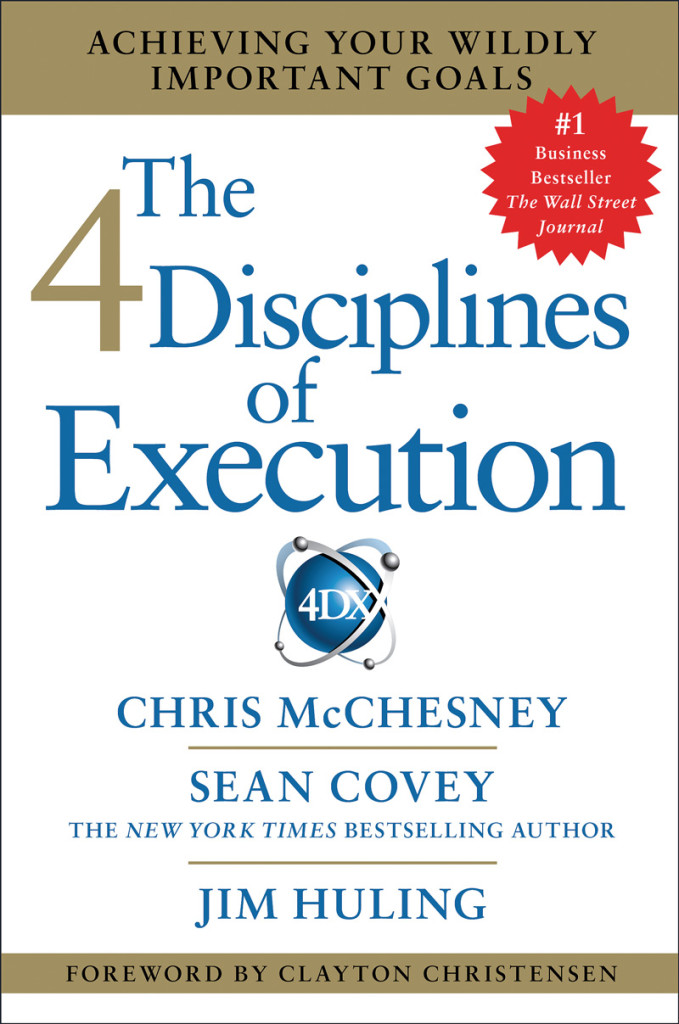Have you ever met anyone who graduated with a degree in business execution? Strategy gets the headlines, the degrees and book shelve space. Newly minted MBAs have ambitious desires to reinvent corporations, set future enterprise direction and envision new futures for their employers. I get it. Strategy is, well, sexy.
The truth though is that very few people get to work on strategy. The vast majority of the work most of us will do—even executives—is ensuring our businesses deliver results. In other words, most of your professional life will entail mastering execution.
A Methodology for Execution
 That’s where The 4 Disciplines of Execution (Simon & Schuster, 2012) by FranklinCovey consultants Sean Covey, Chris McChesney and Jim Huling, becomes a great resource. It’s a proven and scalable process for execution. More than mere theories, the detailed how-to makes this a handbook for moving your strategic plan into action.
That’s where The 4 Disciplines of Execution (Simon & Schuster, 2012) by FranklinCovey consultants Sean Covey, Chris McChesney and Jim Huling, becomes a great resource. It’s a proven and scalable process for execution. More than mere theories, the detailed how-to makes this a handbook for moving your strategic plan into action.
The 4 Disciplines:
Discipline 1: What is the one objective you’re willing to make the big bet on to deliver the business results your organization needs? Focus on the wildly important—work with your team to set one Wildly Important Goal (WIG).
Discipline 2: How to align all the work on my team to secure our WIG attainment? Act on the lead measures: Select critical, measureable and predictable tactics that will influence the metric outcomes to ensure your WIG attainment.
Discipline 3: How will everyone in your team know if they’re succeeding at any time? Keep a compelling scoreboard: Lead your team to develop a simple and visible dashboard that is benchmarked, versus your forecast in real time.
Discipline 4: How do I maintain a flexible team to achieve our WIG? Create a cadence of accountability, set weekly half-hour meetings to review scoreboard, report team progress and define next steps to take the following week.
These sound simple enough, but before you move to action—a cautionary note: The only way to drive team execution is to get buy-in from your team members throughout every step of the process. If you attempt to make this a top-down exercise, you’ll fail before you even start.
Turn Process Into Action
As I write this, I find myself in a new job implementing The 4 Disciplines of Execution. We’ve rolled out the four-phase model and are working through Discipline 2 and 3, in which the execution plan develops with the accompanying metrics. It’s early, but there are a few valuable lessons to share:
- Setting one WIG is both exciting and daunting: We’re courageously aligning our entire team to serve that one goal.
- Your WIG will serve as the lens through which most resources get evaluated and deployed: Expect that there will be changes in budget, campaigns, tactics, and roles and responsibilities.
- Your team must stop many non-WIG historical activities: Do not underestimate how difficult it is for humans to let go of their current projects but be assured that your WIG will demand more than people estimate.
The Four Disciplines of Execution is a great handbook for an essential skill not covered in higher learning institutions, but one which you’ll spend most of your life practicing: Execution.




